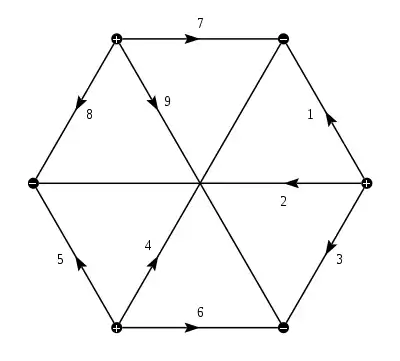9-j symbol
In physics, Wigner's 9-j symbols were introduced by Eugene Paul Wigner in 1937. They are related to recoupling coefficients in quantum mechanics involving four angular momenta

Recoupling of four angular momentum vectors
Coupling of two angular momenta and is the construction of simultaneous eigenfunctions of and , where , as explained in the article on Clebsch–Gordan coefficients.
Coupling of three angular momenta can be done in several ways, as explained in the article on Racah W-coefficients. Using the notation and techniques of that article, total angular momentum states that arise from coupling the angular momentum vectors , , , and may be written as
Alternatively, one may first couple and to and and to , before coupling and to :
Both sets of functions provide a complete, orthonormal basis for the space with dimension spanned by
Hence, the transformation between the two sets is unitary and the matrix elements of the transformation are given by the scalar products of the functions. As in the case of the Racah W-coefficients the matrix elements are independent of the total angular momentum projection quantum number ():
Symmetry relations
A 9-j symbol is invariant under reflection about either diagonal as well as even permutations of its rows or columns:
An odd permutation of rows or columns yields a phase factor , where
For example:
Reduction to 6j symbols
The 9-j symbols can be calculated as sums over triple-products of 6-j symbols where the summation extends over all x admitted by the triangle conditions in the factors:
- .
Orthogonality relation
The 9-j symbols satisfy this orthogonality relation:
The triangular delta {j1 j2 j3} is equal to 1 when the triad (j1, j2, j3) satisfies the triangle conditions, and zero otherwise.
3n-j symbols
The 6-j symbol is the first representative, n = 2, of 3n-j symbols that are defined as sums of products of n of Wigner's 3-jm coefficients. The sums are over all combinations of m that the 3n-j coefficients admit, i.e., which lead to non-vanishing contributions.
If each 3-jm factor is represented by a vertex and each j by an edge, these 3n-j symbols can be mapped on certain 3-regular graphs with 3n vertices and 2n nodes. The 6-j symbol is associated with the K4 graph on 4 vertices, the 9-j symbol with the utility graph on 6 vertices (K3,3), and the two distinct (non-isomorphic) 12-j symbols with the Q3 and Wagner graphs on 8 vertices. Symmetry relations are generally representative of the automorphism group of these graphs.
See also
- Clebsch–Gordan coefficients
- 3-j symbol, also called 3-jm symbol
- Racah W-coefficient
- 6-j symbol
- 9-j symbol
References
- Biedenharn, L. C.; van Dam, H. (1965). Quantum Theory of Angular Momentum: A collection of Reprints and Original Papers. New York: Academic Press. ISBN 0120960567.
- Edmonds, A. R. (1957). Angular Momentum in Quantum Mechanics. Princeton, New Jersey: Princeton University Press. ISBN 0-691-07912-9.
- Condon, Edward U.; Shortley, G. H. (1970). "Chapter 3". The Theory of Atomic Spectra. Cambridge: Cambridge University Press. ISBN 0-521-09209-4.
- Maximon, Leonard C. (2010), "3j,6j,9j Symbols", in Olver, Frank W. J.; Lozier, Daniel M.; Boisvert, Ronald F.; Clark, Charles W. (eds.), NIST Handbook of Mathematical Functions, Cambridge University Press, ISBN 978-0-521-19225-5, MR 2723248
- Messiah, Albert (1981). Quantum Mechanics (Volume II) (12th ed.). New York: North Holland Publishing. ISBN 0-7204-0045-7.
- Brink, D. M.; Satchler, G. R. (1993). "Chapter 2". Angular Momentum (3rd ed.). Oxford: Clarendon Press. ISBN 0-19-851759-9.
- Zare, Richard N. (1988). "Chapter 2". Angular Momentum. New York: John Wiley. ISBN 0-471-85892-7.
- Biedenharn, L. C.; Louck, J. D. (1981). Angular Momentum in Quantum Physics. Reading, Massachusetts: Addison-Wesley. ISBN 0201135078.
- Varshalovich, D. A.; Moskalev, A. N.; Khersonskii, V. K. (1988). Quantum Theory of Angular Momentum. Singapore: World Scientific. ISBN 9971-50-107-4.
- Jahn, H. A.; Hope, J. (1954). "Symmetry properties of the Wigner 9j symbol". Physical Review. 93 (2): 318. Bibcode:1954PhRv...93..318J. doi:10.1103/PhysRev.93.318.
External links
- Stone, Anthony. "Wigner coefficient calculator". (Gives answer in exact fractions)
- Plasma Laboratory of Weizmann Institute of Science. "369j-symbol calculator". (Answer as floating point numbers)
- Fack, Veerl; van Dyck, Dries. "GYutsis Applet".
- Johansson, H.T.; Forssén, C. "(WIGXJPF)". (accurate; C, fortran, python)
- Johansson, H.T. "(FASTWIGXJ)". (fast lookup, accurate; C, fortran)